How SMEs Use Artificial Intelligence in 2024 - Survey Results

In 2024 most businesses that operate digitally are already using artificial intelligence in their operations. From customer service to decision making there are few, if not any companies that haven’t at least tried to use artificial intelligence. But before getting into the subject of how SMEs use artificial intelligence, let’s take a look at the theoretical aspects of AI.
According to John McCarthy, artificial intelligence refers to “the science and engineering of making intelligent machines” (McCarthy, 1958). John McCarthy is also considered the father of AI, and the co-author of the document entitled “Artificial Intelligence” from 1958. Ever since then, and up until 2024 the definition has learned many twists and turns due to AI advancements and how businesses use them.
Moving forward to how businesses use artificial intelligence, it’s known that more than 77% of businesses are either using or exploring the use of AI (Tprestianni, 2024). According to another source, 63% of businesses intend to adopt artificial intelligence on a global scale within the next 3 years (Webster, 2024).
To update, and fill in the statistics gaps for Artificial intelligence, TechBehemoths conducted a survey between July 30, 2024 - August 5th, 2024 across 53 countries and 698 small and medium enterprises. The survey pursued the following objectives:
- Identify to what extent SMEs use artificial intelligence in 2024
- Reveal what SME departments use artificial intelligence most, in 2024
- Identify most prevalent AI types that are being used by SMEs
- Identify the purposes AI is used in SMEs
- Show the implementation maturity of AI in SMEs
- Find how SMEs source artificial intelligence services and products
- Find the most common AI tools used by SMEs in 2024
Survey participants Demographics
As mentioned above and illustrated in the above-maps, survey participants come from 53 countries across the world, with a broader representation of companies from United States, India, Pakistan, United Kingdom, and Ukraine. Nonetheless, countries such as Bahrain, Switzerland, Hungary, and Ethiopia are also represented by at least two companies.
At the same time, we must note that in our survey, most of the respondents come from technology companies, which have a slightly different structure than other types of companies. The reason why the survey pool consists of primarily technology companies lies in the topic itself - most advanced artificial intelligence tools and technologies are very likely to be used by tech companies rather than other types of companies.
Demographics - Survey participants' company size
The company size of survey participants’ is ranged between 2 and 50+ employees, which fully complies to the definition of Small and Medium Enterprise. Another definition of small and medium enterprise says that “[...]are named by adjectives indicating the size, thus economists tend to divide them into classes according to some quantitative measurable indicators. The most common criterion to distinguish between large and small businesses is the number of employees” (Hatten, 2011).
To be more precise, the distribution of company size of this survey is as follows:
- 30.9% of respondents come from SMEs with 2-9 employees
- 21.2% of the respondents represent SMEs with 10-20 employees
- 22.1% of the respondents come from SMEs with 20-50 employees
- And ultimately. 25.8% of the respondents represent SMEs with more than 50 employees, but not crossing the definition line of SME.
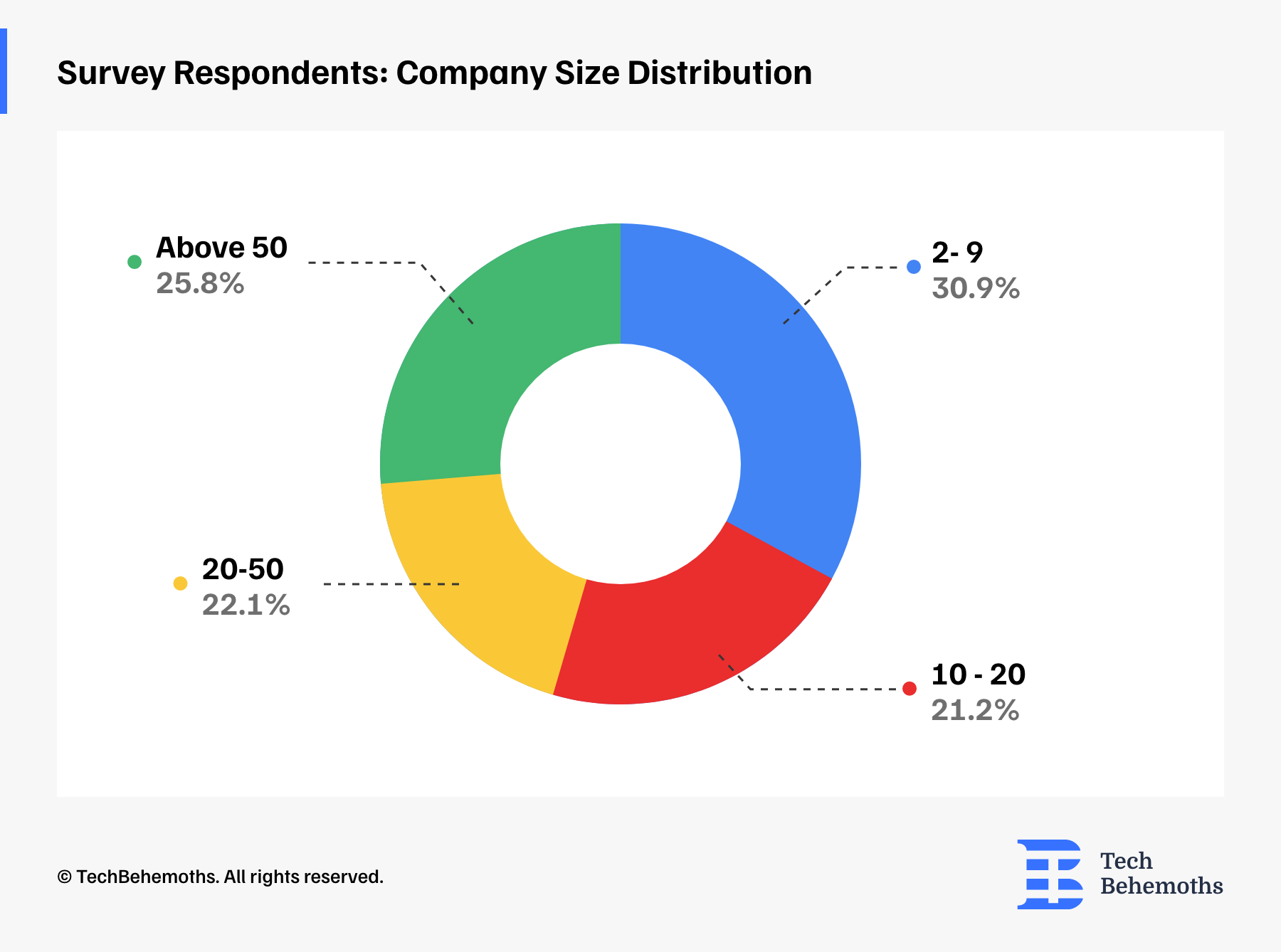
Demographics - Survey respondents' position within the company
While the survey was mailed to companies and was open to everyone, TechBehemoths aimed to collect responses from decision-makers, managers, and representatives of SME departments that use AI the most. Therefore, from the total of 698 survey respondents, 24.4% were CEOs, 20.3% of respondents hold the position of Chief Marketing Officer, 18% of respondents were SME founders, 14.3% of respondents were Chief Technology Officers. In this survey also took part Business Developers (3.7%), CXO (2.3%), and SME partners (2.8%). Other departments were represented by a total of 14.3%. Considering the quantitative nature of this research, the survey is considered to be valid as long as the there are represented more than 3 departments of a company (Ho, T, 2015).
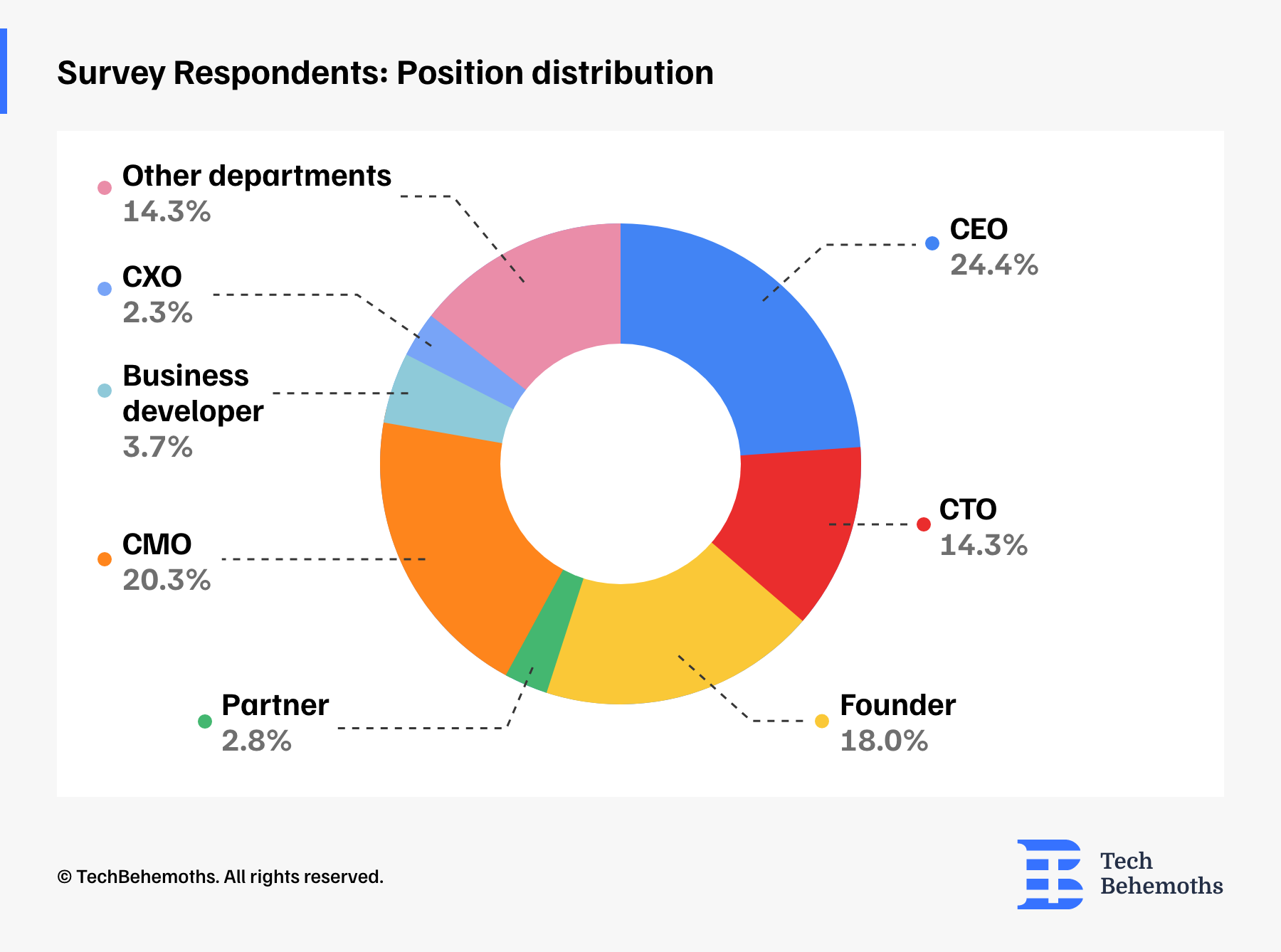
To What Extent SMEs Use AI in Their Activities in 2024
To achieve the first objective of this research, the survey’s first question was: To what extent does your company utilize AI in its daily operations? For a better graphical representation, we used a Likert scale, where SME representatives had four options to choose from:
- Slightly
- Moderately
- Extensively
- Fully integrated
Since there are no known studies and references available about the extent to which SMEs use artificial intelligence in their activities, the present survey results shall be considered canonical.
Therefore, the results show that 45.16% of SME professionals use AI moderately, while other 32.71% of SME professionals use AI extensively. The study also shows that 12.36% of SMEs use AI slightly, and only 7.37% of SMEs have fully integrated AI in their activities, operations, and services.
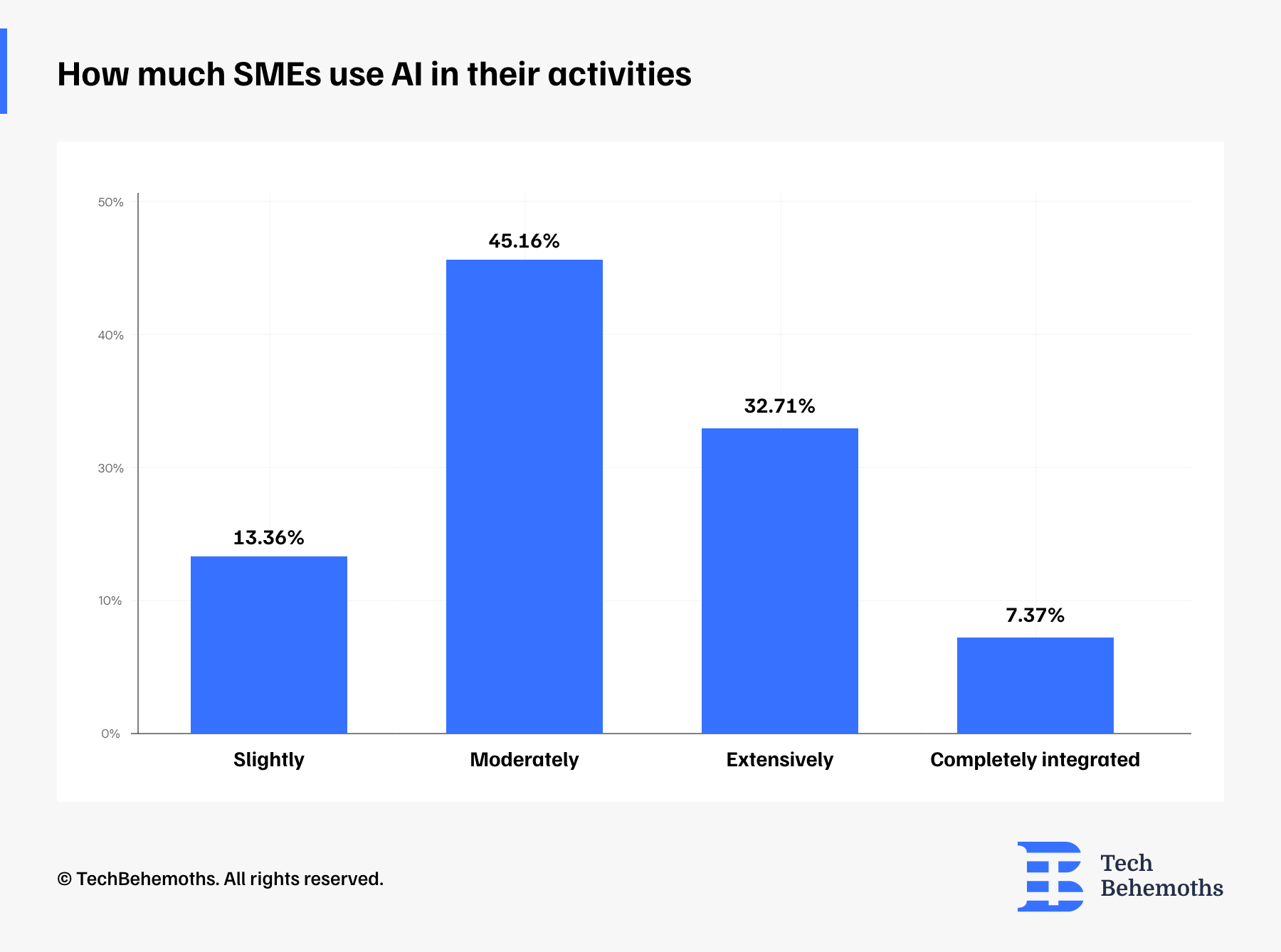
Considering that 63% of businesses plan to adopt AI in the next three years, which is by 2027, the survey results validate the predictions and business intent exposed previously by Webster, in the 149 statistics article. On the other hand, we consider that AI adoption could meet consumer market resistance if SMEs adopt and implement AI faster than their audience. It is also important to note that some markets like Western European countries, and North American markets could move faster compared to other, developing countries in South America, Central Asia, or Africa. The adoption and AI usage by SMEs are strongly related to consumers' access to technology. Therefore, on a global scale, SME AI adoption will always be unevenly distributed from a geographical standpoint.
SME Departments that use AI most
The current research shows that AI is used most by SMEs in sales and marketing. 80.2% of SMEs use AI in this direction. The next most popular direction where AI is used is (web, mobile, and software) development - an option that 65% of respondents have selected. According to Kulkarni, R. H., & Padmanabham (2017), artificial intelligence improved processes like software testing, and software prediction by 11% to 20% since it was implemented back in 2017. Now, 7 years later, the improvements shown by AI could be significantly higher.
The current survey results also show that 60.4% of SMEs use artificial intelligence for research and development purposes which varies from industry to industry, depending on where most companies activate. Nonetheless, considering that most responding companies are from the technology sector, there is a probability that AI is used in machine learning, data analysis and development/training of other AI tools that are yet to emerge in the near future. The 4th most popular direction where SMEs use AI is for advertising purposes. Unlike marketing, the advertising direction in this survey refers to paid advertising solutions that use AI. 59.4% of SMEs use AI in advertising. It’s either for AI-based media buying/selling solutions, or for integrating AI as a part of their advertising campaigns, which include but it’s not limited to content creation, campaign result prediction, and budget estimation. SMEs also use AI for design purposes. Survey results show that 56.7% of SMEs use AI for designing their products, or as an integral part of their services, such as AI-designed wireframes, outdoor banners, websites, or other digital products. The same survey results show that only 33.1% of SMEs use AI for Customer Service. It seems that the chatbot era is coming to an end. Even though the global statistics show that 67% of consumers used at least one chatbot in the last 12 months (Connell, 2024), there are no evidence nor data about the quality chatbot experience. Human resource management and SEO is less used by SMEs in 2024 compared to the directions mentioned above. Only 21.7% of SMEs use AI for HR and 20.2% use AI for SEO. Regarding AI solutions for HR, businesses tend to believe more people in hiring rather than automation as hiring tends to be a long-term commitment on both sides. As for SEO, the recent search engine algorithm updates, that penalize AI-generated content, and unreliable, generalistic information AI provides have turned the tides back in the favor of USG (User Generated Content).
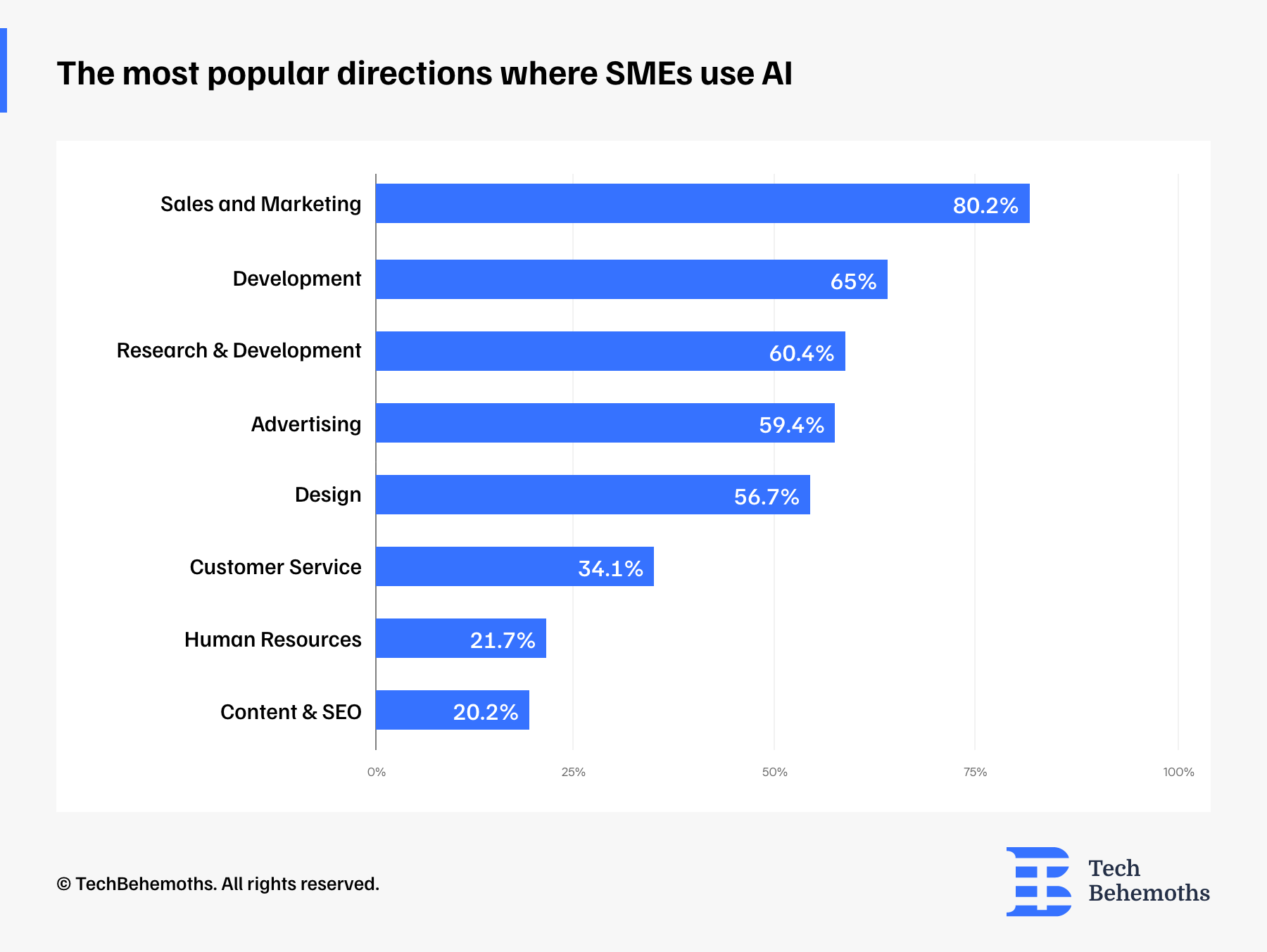
The most prevalent AI types in SMEs
Artificial intelligence is also structured in different branches that are more, or less popular depending on the area it is being used. One of the survey’s objectives is to identify what types of AI SMEs use in business activities. The results show that out of 698 SMEs, 68.7% use Natural Language Processing (NLP). NLP refers to computing and analyzing the speech, and as is a part of AI (Gillis et al., 2024). NLP is used by SMEs particularly to disseminate large amount of information, or to generate structured content, such as visualizations, and texts. However, NLP is more than just a text processing and generation tool, and depending on the scale and industry - it can be used for other purposes, such as creating voice assistants, and grammar tools for morphological segmentation and sentence breaking among others. 65% of SMEs use Machine Learning as a part of AI adoption. According to the Oxford Dictionary, Machine Learning refers to “the use and development of computer systems that are able to learn and adapt without following explicit instructions, by using algorithms and statistical models to analyze and draw inferences from patterns in data” (Oxford English Dictionary, 1953). In other words SMEs use Machine learning (ML), or ML services to analyze existing datasets, and predict/estimate patterns, including behavior patterns in the future. It is very likely that most of these 65% of SMEs are represented by tech companies primarily, followed by representatives from other industries as well.
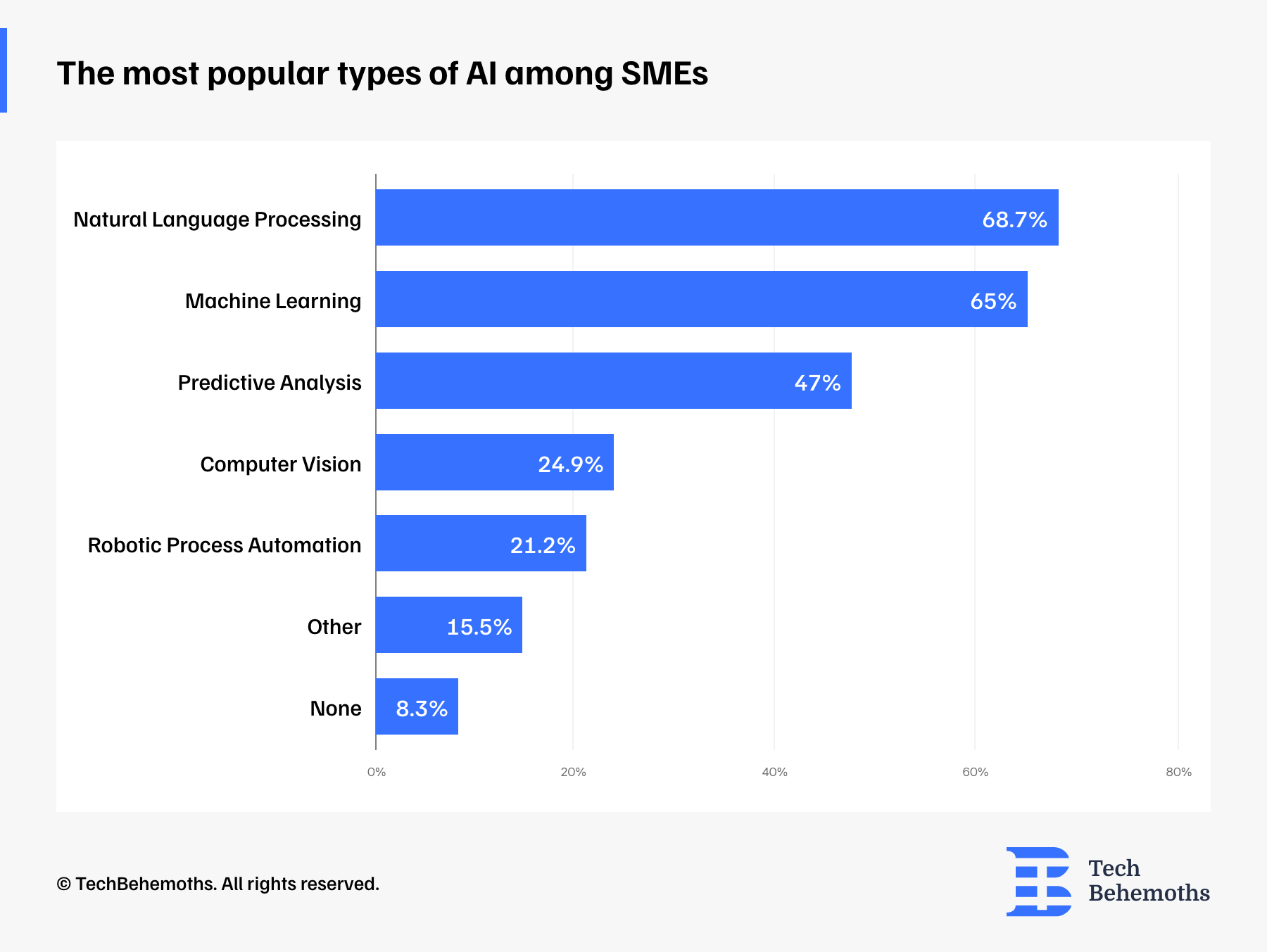
47% of SMEs are using Predictive Analysis as a type of AI. According to Google, the definition of predictive analytics refers to “the process of using data to forecast future outcomes. The process uses data analysis, machine learning, artificial intelligence, and statistical models to find patterns that might predict future behavior” (Google Cloud, 2024). As the definition mentions, predictive analytics is a part of AI that is interdependent with other AI parts. When it comes to SMEs - the use of predictive analytics refers to AI-based tools that are able to provide predictive analysis, but could also refer to companies that develop their own predictive models and tools. Computer vision - a field of artificial intelligence (AI) that uses machine learning and neural networks to teach computers and systems to derive meaningful information from digital images, videos, and other visual inputs—and to make recommendations or take actions when they see defects or issues (IBM, 2024) - is also used by 24.9% of SMEs. At the same time, computer vision is one of the most high-risk AI types due to its ability to create deep fakes and use human-based images to create and generate derivative visual content that may attempt to identity theft among others. Robotic process automation (RPA), also known as software robotics, uses intelligent automation technologies to perform repetitive office tasks of human workers, such as extracting data, filling in forms, moving files, and more (IBM, 2024). According to the survey results, RPA is used by 21.4% of SMEs in their business activities.
For what purposes SMEs use AI in 2024?
82% of the content published on the web in 2024 is AI-generated according to the survey results. SMEs declared content writing as the main purpose of using AI, which is very likely since it matches the same period of time when the web has more words than information. While there are contradictory examples where some AI-generated content attracted a lot of traffic and potential customers, and other AI-generated content has been penalized and unpublished from search engine, SMEs continue to use AI as a faster way to generate content, and save both time and money on hiring copywriters. Our editorial note here, is that human-generated content worths now more than it ever did, due to unique human capabilities to research, express, and elaborate their thoughts, compared to AI.
70% of SMEs use AI to publish on social media. This includes text, and visual representation, scheduling, and even engaging with the audience using AI. At the same time, 66% of SMEs use AI for automation purposes. For SMEs AI automation is mostly used to perform repetitive tasks, such as data extraction and filling, customer service interaction, and also AI-based emailing services among others. 59% of SMEs use AI as an inspiration for ads. In other words, 59% of SMEs don’t fully use AI in ads, but rather have AI-generated content at the core of their ads. According to an IBM survey, 85% of advanced adopters have already reduced operating costs with AI in ads (IBM, 2024) The survey results also shows that 57% of SMEs use AI for data analysis, which correlates with a similar proportion of SMEs that use AI for predictive analysis - 47%. Therefore, it means that from a total of 57% of SMEs that use AI for data analysis, 82% of them use it for predictive analytics. AI is also used by SMEs in Web/Mobile development in proportion of 52% according to survey results. As we mentioned previously, most of the respondents represent tech companies, and therefore, Web and Mobile App development is one of the main activities of small and medium tech companies. The least most popular purposes SMEs use AI are as follows:
- For Design Purposes - 49% of SMEs
- For Customer interaction purposes - 39% of SMEs
- For Decision-Making Purposes - 26% of SMEs
- For Predictive Maintenance - 18% of SMEs
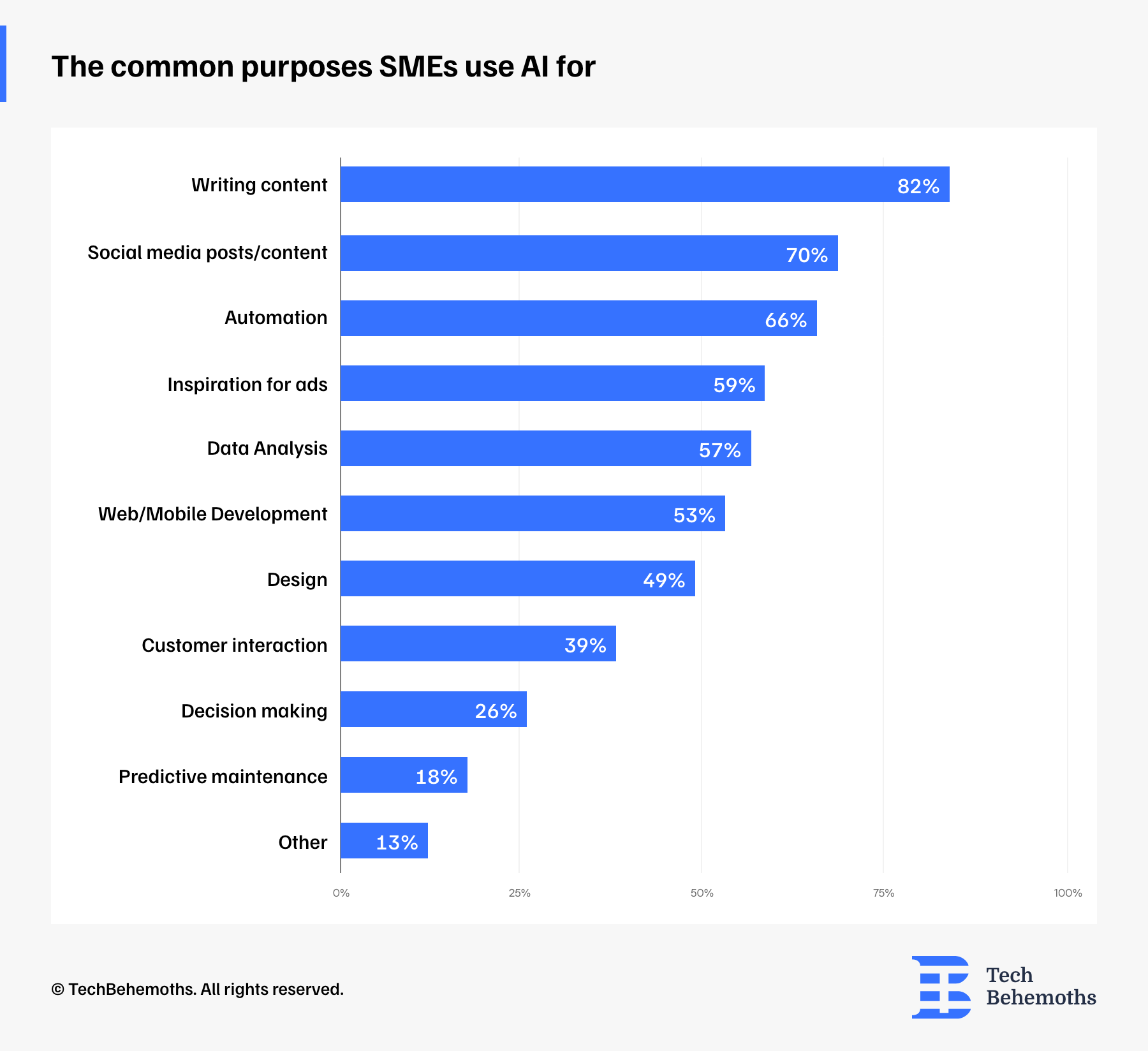
At What Level SMEs Have Adopted AI in 2024?
As AI is being used for the above-mentioned purposes, SMEs are still using it at different levels since not all businesses have equal access to technology, or need AI in an equal manner. Therefore, one of the survey’s purposes is identifying SMEs' AI adoption levels.
The results show that the majority of businesses (47.9%) use AI as early adopters. In other words, businesses have recently started using artificial intelligence in their activities.
However, the results contrast with SMEs that state AI advanced implementation in their activities (31.9%). At the same time 9.8% of SMEs are still exploring options, tools and platforms that provide AI services for their businesses, and only 8.4% of SMEs have declared that are leading edge AI adopters.
For 1.9% of the businesses, AI is not applicable.
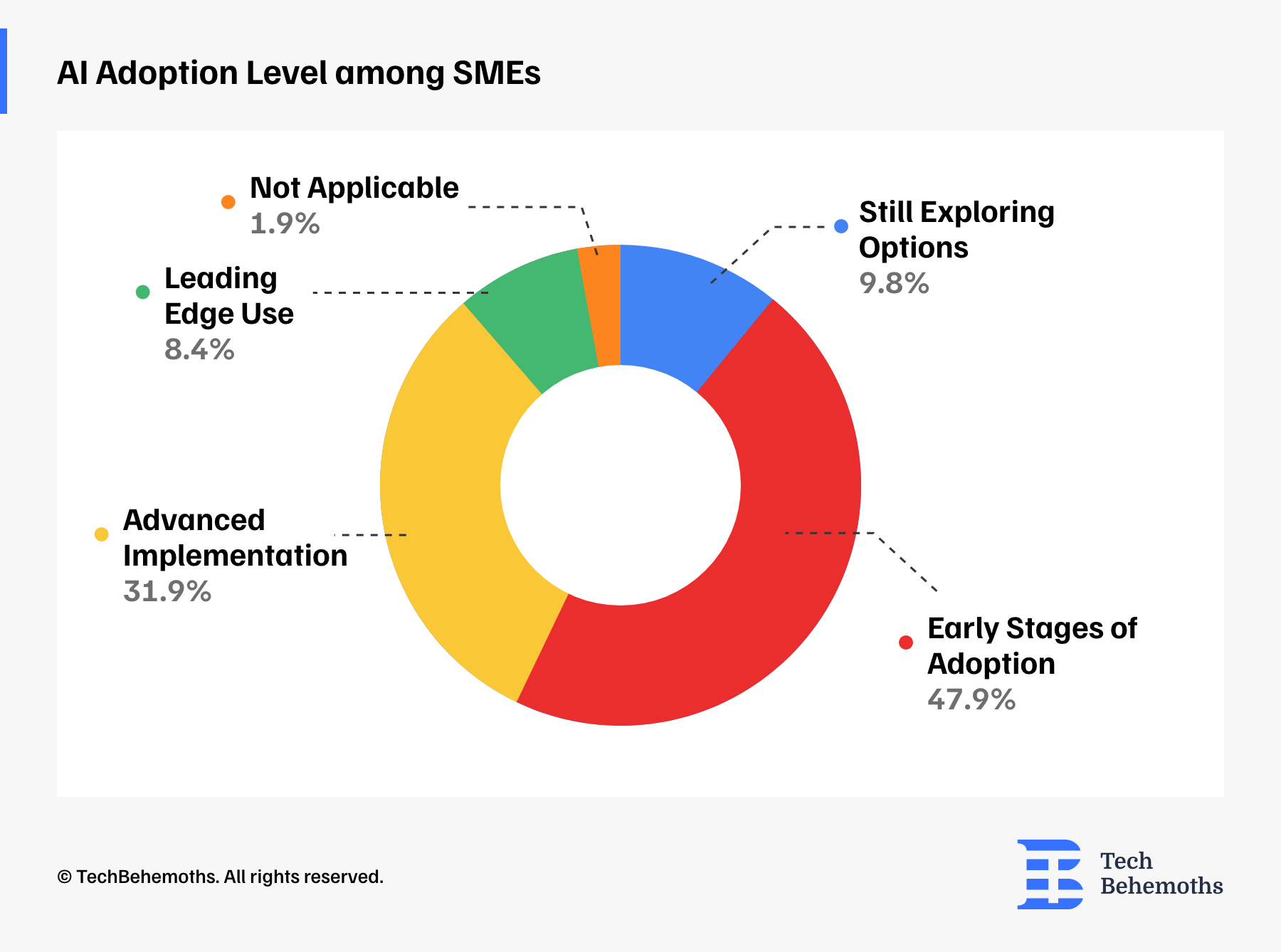
How SMEs Source Artificial Intelligence in 2024
It is also interesting to analyze if SMEs develop and use their own AI tools, or if they are opting for open-source and third-party paid tools and services.
In 2024, 20.2% of SMEs use open-source AI tools, and 15.3% use paid, third-party AI tools for their activities. However, 44.4% of SMEs use both open-source and paid third-party AI tools for business purposes. Only 15.7% of SMEs develop in-house AI tools.
In the context of an unstable and constantly changing AI scene, the market is segmented as well. Free, open-source AI tools have limited capacities and capabilities, but for 20.2% of SMEs seems to be enough, as they are focusing more on human intelligence. Paid, third-party AI tools and platforms provide advanced services and additional features, but it might be too costly for businesses to adopt and implement them on a larger scale. There are no better examples with free and paid AI services to give than Gemini and Gemini Advanced, or ChatGPT 4.0 mini and ChatGPT 4.0.
Yet, the most suitable solution for SMEs proved to be a mix of free and paid AI tools and services to use.
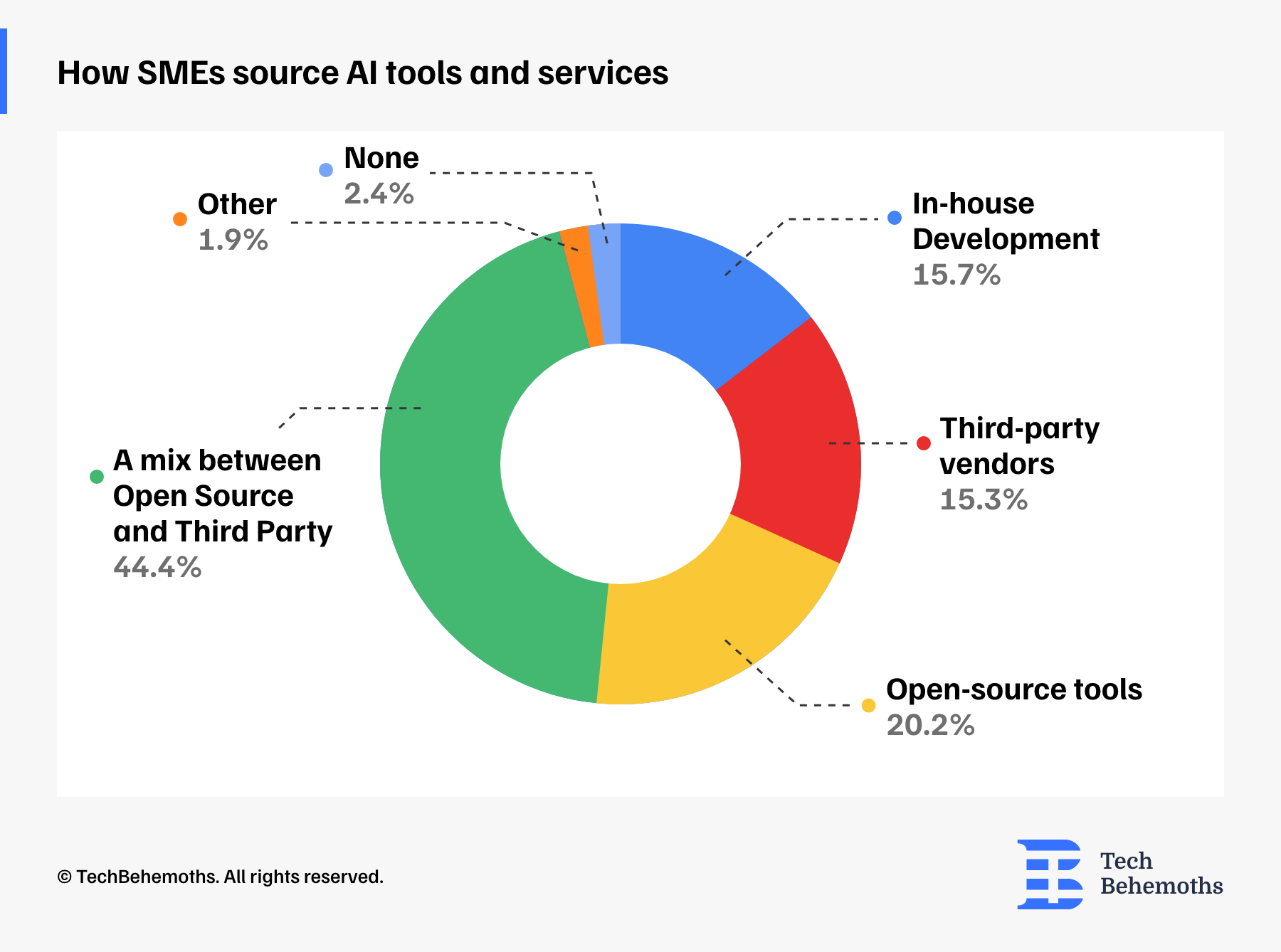
Challenges SMEs face in adopting and implementing AI
In the process of adopting and implementing artificial intelligence, there are challenges that small and medium enterprises face. Among the most notable challenges are data privacy and security concerns. In 2023, in an article on Reuters signed by Sher & Benchlouch, there was evidence that AI tools are at the edge of breaching a series of data privacy laws such as GDPR in the EU, Health Insurance Portability and Accountability Act (HIPAA), Children's Online Privacy Protection Act (COPPA) and the California Consumer Privacy Act (CCPA) - in the US (Sher & Benchlouch, 2023). Later, tech giants that develop AI systems like Google, Microsoft/OpenAI and Nvidia announced that they have modeled AI to respect data privacy according to the laws, but as the survey results show, in 2024 36.9% of SMEs are still concerned about AI data privacy breaches and have security concerns when implementing AI tools.
Another challenge in adopting AI is the integration with existing systems. Most of the technologies SMEs use across the globe are not compatible with or difficult to integrate with AI tools and services, which makes the implementation more difficult. 33.6% of SMEs have declared that AI integration with existing systems is a persistent problem.
At the same time, SMEs are concerned about how AI will impact Return on Investment after implementing it. There are few studies on the financial impact of AI adoption in SMEs and the risk of a negative impact on financial aspects is a factor of concern for 29% of SMEs.
Since AI is relatively new on the business market, and the AI market has not reached a competitive maturity, the prices vary and produce high costs for SMEs. The survey results show that 27.6% of SMEs find AI too costly at this moment, and would rather wait for proven and cheaper AI solutions when the prices will drop. We never know how much this will take, and how much the prices will drop for AI solution, but it seems to be a safer solution rather than assuming the risk of implementing it blindly.
The least, yet notable challenge SMEs face in adopting AI is the lack of skilled staff that could handle, manage and control it. 26.3% of SMEs consider that it’s difficult to find skilled staff for AI implementation and management right now.
On the other hand, 29% of SMEs state that they didn’t meet any significant challenges in adopting and implementing AI tools, services, and solutions.
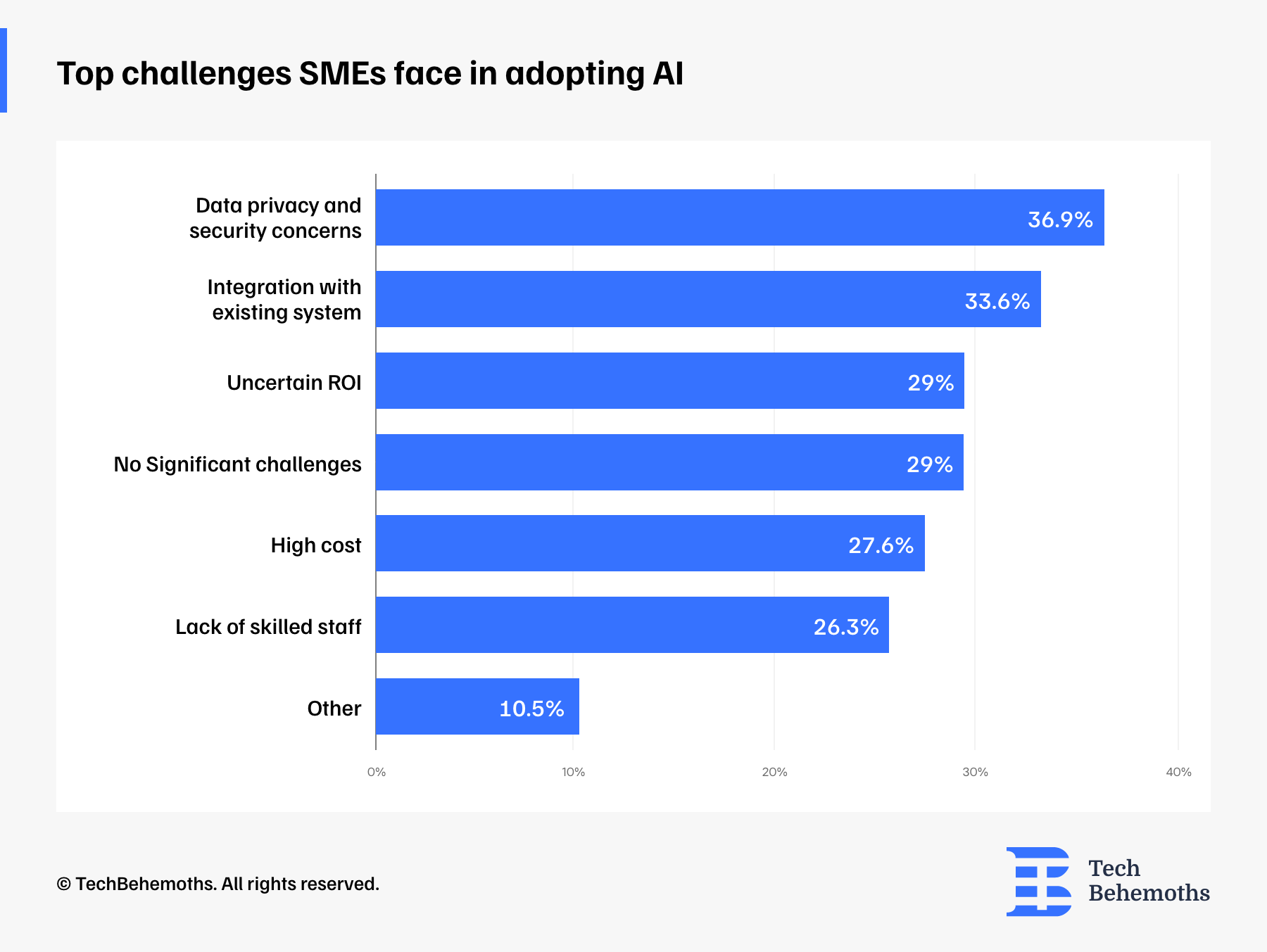
How SMEs measure AI impact or Success
In a recent article released by The Economist, the analysis showed that AI had no economic impact so far (The Economist, 2024). However, SMEs that have implemented AI technologies are measuring AI impact, efficiency and results that the technology brings to their companies.
The KPIs are both generic, but not surprising, as 58.4% of SMEs measure AI results in company and employee efficiency and productivity. The second most popular indicator for AI usage is the ability to bring innovation and develop new capabilities within these companies (16.6%).
Probably the most practical example of AI results in SMEs is shown by the third-most-popular KPI. Only 10.1% of SMEs measure AI's impact on ROI and cost-saving. At the same time, 4.6% measure AI's impact on their business via customer satisfaction. There are also SMEs that implemented at some extent AI in their business processes but don’t measure (yet) at all how the technology impacts their company - 8.3% of survey respondents.
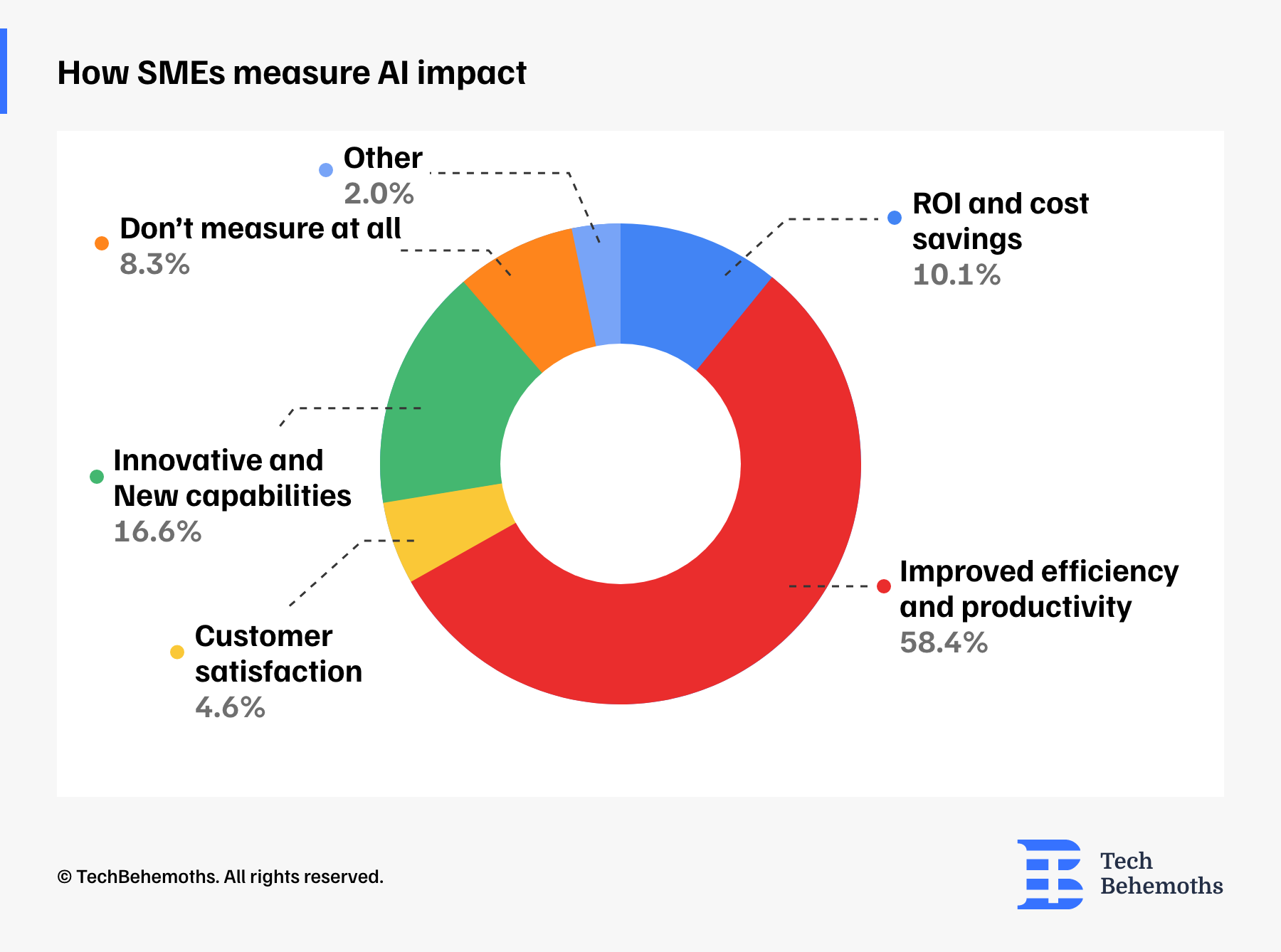
How often AI strategies are reviewed in SMEs
Reviewing and updating strategies is as important as implementing them, we would say. A similar
opinion is shared by SMEs that, when it comes to AI, have a specific frequency of updates and review.
Some businesses review AI strategies more often, while others choose a larger timestamp.
While AI as a technology is unstable and updates with a higher frequency, businesses shape their strategies accordingly, depending on what new capabilities bring these AI updates for them.
According to the survey results, 64.7% of SMEs review and update their AI strategies continuously, on the way. 4.1% of SMEs update their AI strategies twice a year, and 8.2% update and review AI implementation strategies once a year.
14.5% of SMEs say they rarely update their AI implementation strategies, which should be read as less frequent than once per year. 5% of SMEs don’t review and update their AI strategies at all, which may be related to a limited extent of implementation.
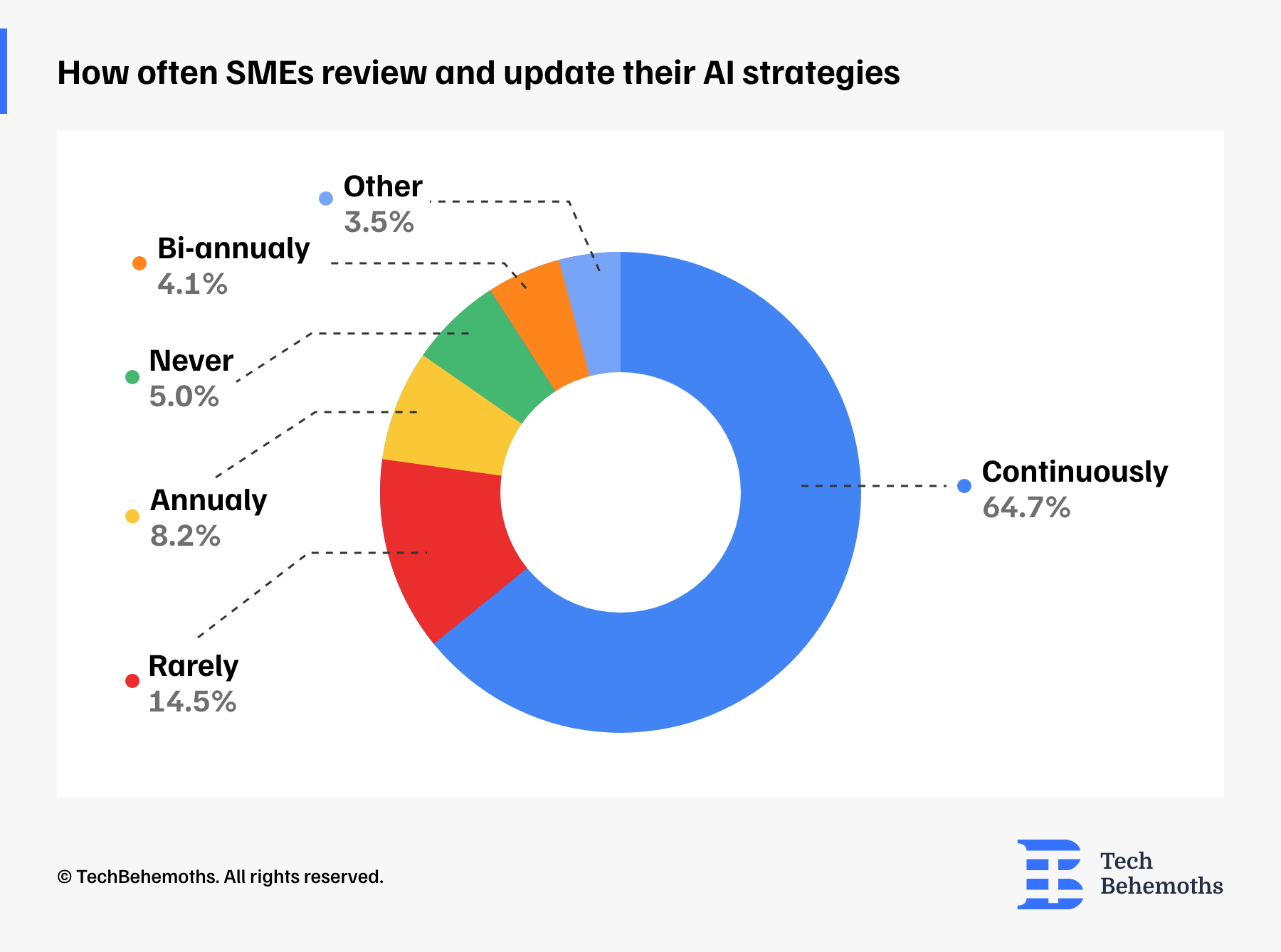
Most common AI tools Used by SMEs in 2024
LLMs are the most common tools SMEs use in 2024 as the survey result shows. Out of all, 93.7% of all SMEs use ChatGPT cumulatively calculated for free and paid versions. On the same note, the second most common AI tool among SMEs is Gemini, formerly known as Bard which was developed by Google. Yet, the percentage of SMEs that actually use Gemini is only half of the one that uses ChatGPT. Copilot from Microsoft, which was recently launched on devices that run on Windows OS, has a surprising 44.39% usage rate among SMEs. Also, noteworthy to mention AI tools used by SMEs are - Claude with a 29.59% usage rate, and Jasper AI with 17.48% followed by YouChat with 4.03%, Perplexity AI with 1.35%, and Quillbot with 0.89%.
At the same time, 16.56% of SMEs declared that they use other tools, different from those that were mentioned above.
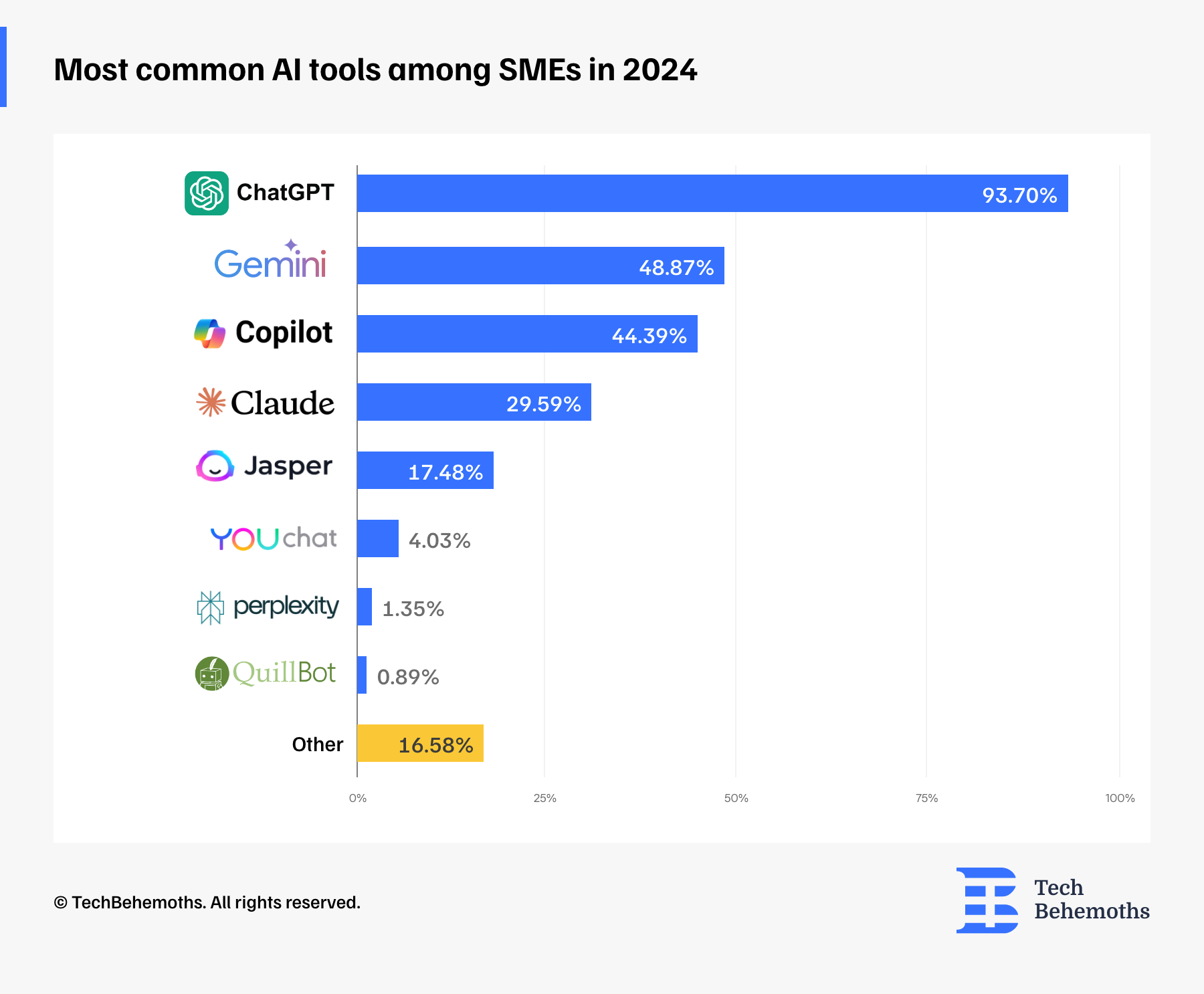
How Much SMEs spend per month on AI tools in 2024
Considering that most SMEs rather use third-party AI tools than develop themselves, there is also spendings associated with these AI tools.
It turns out that 65.9% of SMEs spend less than $1000 per month for AI tools. At the same time the survey results show that 24.6% of SMEs spend between $1000-$5000 per month for AI tools.
Only 1.7% of SMEs are spending between $5000-$10000 monthly on AI tools, and the same percentage of SMEs spend between $25,000 - $50,000 monthly on AI tools.
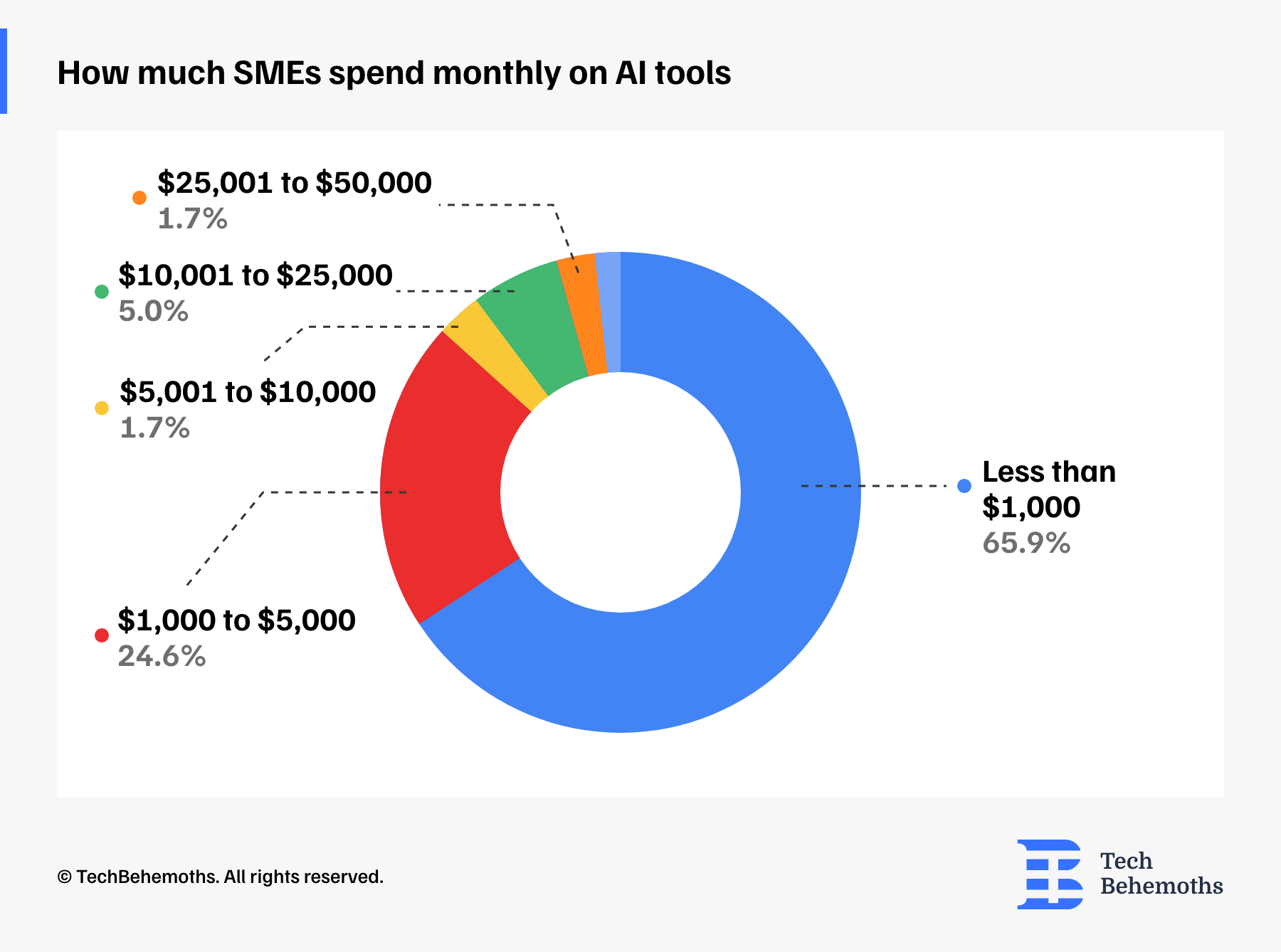
Conclusions
After a careful look ar these statistics, many companies could find themselves in the shoes of different segments analyzed in this survey. The most important factor that determines AI usage is its usefulness. If AI brings or doesn't bring specific results for businesses it still remains a matter of creativity and compatibility.
At the same time, we must note that the uneven access to AI across the world determines usaage depth. In some regions AI, and especially generative AI is viewed as a miracle, while in other regions is percepted as a superficial representation of creativity.
Of course, AI is limited by some regulations and laws to prevent identity theft, and other cybercrime - which makes it as we know it today. If and when AI will replace human work on a global level - it's still a question with no answer. In 2024, AI still needs to be tailored, taught and led by human minds to fit consumer acceptance.
References
-
John McCarthy, 1958, “Artificial Intelligence”
-
Tprestianni. (2024, May 30). 131 AI Statistics and Trends for (2024) | National University. National University. https://www.nu.edu/blog/ai-statistics-trends/
-
Webster, M. (2024, August 12). 149 AI Statistics: The Present and Future of AI [2024 stats]. https://www.authorityhacker.com. https://www.authorityhacker.com/ai-statistics/
-
Hatten, T. S. (2011). Small business management: Entrepreneurship and beyond. Cengage Learning, Inc..
-
Ho, T. (2015). Exploring the decision-making process in statistical data analysis: A qualitative study of quantitative researchers (Doctoral dissertation, UCLA).
-
Kulkarni, R. H., & Padmanabham, P. (2017). Integration of artificial intelligence activities in software development processes and measuring effectiveness of integration. Iet Software, 11(1), 18-26.
-
Connell, A. (2024, June 17). 50 critical Chatbot statistics you need to know for 2024. Adam Connell. https://adamconnell.me/chatbot-statistics/
-
Gillis, A. S., Lutkevich, B., & Burns, E. (2024, February 15). natural language processing (NLP). Enterprise AI. https://www.techtarget.com/searchenterpriseai/definition/natural-language-processing-NLP
-
machine learning, n. meanings, etymology and more | Oxford English Dictionary. (n.d.). https://www.oed.com/dictionary/machine-learning_n?tl=true
-
What is predictive analytics and how does it work? | Google Cloud. (n.d.). Google Cloud. https://cloud.google.com/learn/what-is-predictive-analytics
-
What is Computer Vision? | IBM. (n.d.). https://www.ibm.com/topics/computer-vision
-
What is Robotic Process Automation (RPA)? | IBM. (n.d.). https://www.ibm.com/topics/rpa
-
Team, E. E. C., & Team, E. E. C. (2024, July 29). Elevating customer service: Why IBM watsonx is the perfect fit for public-facing industries. IBM Blog. https://www.ibm.com/blog/elevating-customer-service-why-ibm-watsonx-is-the-perfect-fit-for-public-facing-industries/
-
Sher, G., & Benchlouch, A. (2023, October 31). The privacy paradox with AI. Reuters. https://www.reuters.com/legal/legalindustry/privacy-paradox-with-ai-2023-10-31/
-
The Economist. (2024, July 2). What happened to the artificial-intelligence revolution? The Economist. https://www.economist.com/finance-and-economics/2024/07/02/what-happened-to-the-artificial-intelligence-revolution
Partner companies
We at TechBehemoths are grateful to all partner companies for their active involvement in spreading the survey within their network and beyond it. Like always, allow us to credit you for the entire effort you have made to make this survey even more insightful and relevant for companies and industries across the world:
- 2N Consulting Group, United States
- 42group, United Kingdom
- Acropolium, Czechia
- AITC International, Nepal
- Alltegrio, United States
- Altlier, United Kingdom
- Alto Servicios Comunicación, Spain
- Amoeba Labs, Nepal
- Appomart, Serbia
- AppWT LLC, Websites and More, United States
- Aptagon Technologies, United Kingdom
- Aroasis Softech, India
- Artxtreme, Philippines
- Atta Systems, Romania
- Beach Chair Marketing, Canada
- Beesoul LLC, United States
- Betlace, Ukraine
- BoostenX, Singapore
- Briskstar Technologies LLP, India
- BRND WGN, Malta
- BugRaptors, India
- Bulcode 2016 Ltd., Bulgaria
- Business Config, Portugal
- Byteout Software, Serbia
- CDN Solutions Group, United States
- Chimp&z Inc, India
- Clarika Group, Argentina
- Codezela Technologies Ltd, United Kingdom
- Codezela Technologies, Sri Lanka
- Codment, United States
- Corporation Pop Ltd, United Kingdom
- Cosmico Studios, United States
- Cozmotec, Ireland
- Crystal Translation and Content Creation, Lebanon
- Cygnis Media, United States
- DarkSky Digital, South Africa
- Deez Graphics & Studioz, Nigeria
- DevIT Group, Ukraine
- Dexoc Solutions, India
- Digismiths, India
- Digital Agency, Nepal
- Digital marketing and Advertising, Nigeria
- Digitaleap, Pakistan
- Digitalhound, United Kingdom
- Director, India
- Dot IT, United Arab Emirates
- DTC Infotech, India
- Dudobi, South Africa
- EDIIIE, India
- Editoteka, Mexico
- Edulife Agency, Bangladesh
- Element Media, Palestine
- Elit-Web, United States
- Elites, Lebanon
- Emerline, United States
- Encrypted Infoweb, India
- Evonicsoft FZE LLC, United Arab Emirates
- Exemplifi, United States
- Felice Agency, United States
- Fingent, United States
- First Launch, India
- First Line Software, United States
- Fively, Poland
- Fora Soft Limited, Hong Kong
- FROST BOX PRESS, United Kingdom
- Fulminous Software, India
- Glorium Technologies, United States
- Green Group Studio, United States
- Greenmor E-Commerce Pvt Ltd, India
- Grio, United States
- Grow My Business, New Zeeland
- H16M Agency, Morocco
- Henderson Media LLC, United States
- Hivekind, Malaysia
- Holicky Corporation, United States
- Huspi, Poland
- I Concept Digital, Malaysia
- Influence IT Consulting Pty Ltd, Australia
- Information Technology Services, India
- Infotyke, India
- InStandart, United Kingdom
- Invenpro, United Arab Emirates
- IR Solutions, Pakistan
- iRoid Solutions, India
- Isle Geeks, South Africa
- IT Brick, United States
- ITD-GBS Tokyo, Japan
- JAM-Forte Technologies Ltd,Nigeria
- Kellton, United States
- Klein Media, Netherlands
- Koda, India
- Leeway, Lebanon
- Lemon Pulse, United Kingdom
- Leobit, Ukraine
- Leoceros, Lebanon
- LITSLINK, Ukraine
- LiveWebMedia, United States
- Loovatech, Estonia
- M+ Software, Indonesia
- Marketer Medley LLC, United States
- Marketing, India
- Milies, Armenia
- minic studio, Romania
- Ministry of Programming, Bosnia and Herzegovina
- Mobiteam, Germany
- MONGID | Software House, Palestine
- Morph Collective, United Arab Emirates
- Morphsites, United Kingdom
- Movadex, Ukraine
- Naturality digital, China
- NERDZ LAB, Estonia
- Newman Web Solutions Agency, United States
- Nick France Design, United States
- Nkom, Germany
- Nokto Studios SRL, Romania
- OBI Services LLC, Philippines
- Objects, Egypt
- Omega Digital, Vietnam
- One Pixel Media, Vietnam
- Onix-Systems LLC, Ukraine
- Onyx8 Digital Agency, Spain
- Ortus Knights, United States
- Parasol leads, United States
- Phaedra Solutions, Pakistan
- PixoLabo, Japan
- PowerFlite Communications LLC, United States
- Qarbon IT, Poland
- Qubed Agency, Romania
- Radiant Elephant, United States
- Real Wisconsin Website Design, United States
- RebelDot Solutions SRL, Romania
- Redbee Software, Romania
- RetroStyle Games, Ukraine
- Rocket House Pictures, United States
- Rocket Systems, United States
- Ronik, Croatia
- Ruby Search Solutions Pty Ltd T/A Ruby Digital
- Sailing Byte, Poland
- Saint Rollox Digital, Australia
- Saivra Technologies LLC, United States
- Sanara Infotech, Bahrain
- Seclinq, Netherlands
- SENLA, Poland
- SEO Expert Gold Coast, Australia
- SEO Lady Ltd, United Kingdom
- SEOHUB.PK PRIVATE LIMITED, Pakistan
- Setronica, Slovenia
- ShotCoder Tech, Nepal
- Sibers, United States
- Sigli, Belgium
- Significa, Portugal
- Silk Data, Germany
- Silk Data, Poland
- Silkdev, Tunisia
- SinzerAD, Andorra
- Sixth City Marketing, United States
- Sixtwo Agency, United Kingdom
- Square63, Pakistan
- Starboy Creative, LLC, United States
- Startbit IT Solutions Pvt. Ltd., United States
- Strategeos, India
- SunHouse Marketing, Canada
- syntelligenceIT (Pvt) Ltd, Sri Lanka
- TeamStation AI, United States
- Tecalis, Spain
- TechnoLyte, Pakistan
- TeckPath, Canada
- Telsa Media, United Kingdom
- Teners, Nigeria
- TH-EY S&D LTD, United Kingdom
- The DM Lab, United Kingdom
- The Generalissimo Media, Nigeria
- Thinkogic, India
- ThinkWeb Bulgaria, Bulgaria
- TouchBasePro, South Africa
- TREPPAN TECHNOLOGIES, Uganda
- Tresify Lab, Bangladesh
- UAATEAM, Ukraine
- Umbrella IT, United States
- Uppfy Digital, Kenya
- Usetech, United Arab Emirates
- VegaTech, South Africa
- Veltrix Consulting, Egypt
- Vention, United States
- Virtual Office Point, Kenya
- VM Project, Russia
- VOLO, Armenia
- VT Netzwelt, United States
- wavenex limited, Hong Kong
- WDI, India
- Weblineindia, India
- WebOrigo Magyarország Zrt., Hungary
- Webshot, India
- WebsManiac Inc, India
- Webssential, Portugal
- WeeTech Solution Pvt Ltd, India
- Weezli, Lebanon
- WEZOM, United States
- Wild Creek Web Studio, India
- Williams Web Solutions, United States
- Wireless Computer Services, Nigeria
- WPRiders, Romania
- XB Software, Poland
- Xpertech Solutions Group,Nigeria
- YetiStudio, Nepal
- Yovista, Morocco
- ZAPTA Technologies, Pakistan
- Zfort Group, Ukraine
- ZH IT SOLUTIONS, Pakistan